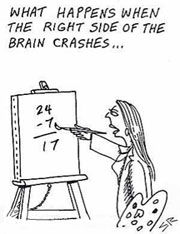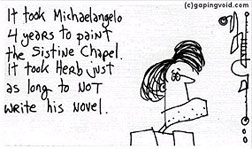

ike many writers, I juggle several projects at one time. I also juggle fiction and non-fiction, and even adult and juvenile writing. It can be a struggle to fit my writing wants and my writing needs into my schedule, but I’ve found a few ways to make my system work. I start by keeping my right and left brain happy.
There’s a funny right brain/left brain test on the web. A silhouette of a dancer turns in either a clockwise or counterclockwise direction. Your right- or left-brain dominance determines the direction you see her spinning. Every time I take that crazy test, I get a different result. Eventually, I figured it out: I’m a writer. (Hold on, now. That’s not the problem.). The problem is that I write just about everything under the sun, from a web content article on thyroid symptoms to children’s once-upon-a-time stories. Not surprisingly, my right- and left-brain sides occasionally rebel.

Research has shown that different sides of the brain control different tasks. The right brain is the feeling side, where imagination rules. Symbols and imagery are deciphered here. The right brain is the spot that believes, appreciates, and presents possibilities. It’s no wonder that fantasy, philosophy, and even religion are right at home here. It’s no wonder, too, that the right brain is the go-to place for fiction writers. All that lovely imagination a writer needs to create characters, paint pretty pictures with words, present plots and somehow solve them is right there, waiting on the right side. After all, fiction is fantasy in the broad sense of the word, even the fantasy that every fiction writer clings to: that someone, someday, will pay for those lovely stories!
But the left brain comes in pretty handy, too, especially for the non-fiction writers. The left brain is the logical side, where details and facts rule. Words and language, order and pattern are entrenched on the left here-and-now, practical side. It’s the home base for all those mathematicians and scientists, but writers are hanging out there, too. Those freelance writers who are busy tracking down facts, interviewing experts, and getting every detail are using their left brain. Editors who know the ins and outs of grammar and punctuation are utilizing the left brain, too. And it’s the reality side of the brain that tells writers the reality of the business of writing: Fiction writing may be swell, but freelance writing pays the bills.
 Of course, writers need both the right and left side of the brain to write just about anything. But have you ever found yourself frustrated, resentful, or dragging on a project? Maybe your brain is trying to tell you something. If you’re spending all of your time digging for details, researching and analyzing information, editing and writing factual copy, then your imagination-starved fiction muse might be drying up. Still, you may not be too keen on watching your monetary input dry up while you ditch your well-paying work and write the Great American Novel. You need a balance between finances and fantasy. What you really need is a way to keep your right and left brain happy!
Of course, writers need both the right and left side of the brain to write just about anything. But have you ever found yourself frustrated, resentful, or dragging on a project? Maybe your brain is trying to tell you something. If you’re spending all of your time digging for details, researching and analyzing information, editing and writing factual copy, then your imagination-starved fiction muse might be drying up. Still, you may not be too keen on watching your monetary input dry up while you ditch your well-paying work and write the Great American Novel. You need a balance between finances and fantasy. What you really need is a way to keep your right and left brain happy!
Many writers divide their writing time between fiction writing and freelance gigs (or business/work writing). You can, too, with a little discipline and a lot of motivation. And one of my fail-proof methods!
Daytime Business vs. Nighttime Fun
Many writers have day jobs, writing or otherwise, that pay the bills but lack in the writing-makes-my-soul-sing department. These writers reserve their evenings for short story plotting, poetry-penning or busting out their hoped-for best-seller. The downside is the trade-off. You may have to give up your favorite TV show, or Bunco nights with the girls. And you may think you couldn’t possibly write after a long day when you’re bone–tired and your brain is mush. But I’ll tell you the secret to after-hours writing: it’s like late-night romance. You think you’re too tired ’til the passion kicks in!
Hide the Dustpan! It’s the Weekend
So, you simply can’t squeeze another writing minute into your day? Set aside some of those weekend hours to work on your favorite writing project. And here’s what you must tell yourself if you want to find some extra time: Dust will be with you always. Give up that “cleanliness is next to godliness” ideal if you’re serious about getting your ideas onto paper!
Halfsies
For writers who work at home, you have choices when it comes to managing your writing. You can change the baby’s diaper or write a few more sentences before you’re overwhelmed by fumes. But if you’re lucky enough to have the house to yourself, you can work on that web content project in the morning, and then take the afternoon to edit your horror story. Or work one day on freelance, and the next on fiction. I’m a halfsies writer myself, but it’s harder for me to change mindsets in the middle of the day. I work better when I give myself a day for paying jobs, then a day for story writing (not-so-much paying jobs). That way, the little voice saying, “One more article!” doesn’t interrupt me half as much!
This is another technique I use to keep peace between the warring factions. I incorporate aspects of both right- and left-brain writing into my specific writing projects. Here’s how:
Finding The Right (Non-Fiction) Stories
I write creative non-fiction all the time. I love how I can add my humor and imaginative crafting into a true-to-life essay. So, yes, it’s non-fiction where facts are important, but like a story, there’s a beginning, a middle and ending. Or you can try more esoteric essays and flex your literary leanings. You can even get a little opinionated and dash off a column. There are tons of markets, national and regional, for essay writing, from Chicken Soup for the Soul to your local newspaper. You’ll be surprised at the nice bit of cash you can earn for your work!
Take Your Interests to the Bank
Travel, food, health, pets, the list of topics goes on and on. So, if you choose to write freelance articles, whether for magazines, web content, or even blogging, at least choose a topic you like! You’ll have the added bonus of being able to sell your idea. Because if you’re excited about a subject, then that excitement will come through in your pitch. (Why do you think so many writers write articles about writing?) And here’s another bonus: when you’re researching a topic that interests you, you’ll really enjoy tracking down all that information.
There’s a story about the famous opera singer, Luciano Pavarotti, and his father. It seems that Pavarotti, though a tremendously talented singer, also studied to be a teacher, and was having a difficult time deciding between the two professions. He asked his father what he should choose, and his father set two chairs in front of him, side by side, and told him to sit. Young Luciano knew he would fall between the chairs if he tried to sit on both and gave his dad a questioning look. “You must pick a chair,” said his father. Sometimes, as writers, we must pick one kind of writing over another, whether for financial or fulfilling reasons. But life has a funny way of changing, so, unlike Pavarotti, your choice doesn’t have to be final. Find what works for you, at this time in your life, make the commitment, and quit expending energy on the what-if game.
Time marches on, so don’t waste another minute. Choose a technique that works for your right- and left brain, and before long, you’ll balance your writing wants with your writing needs, and peace will reign. At least, when it comes to your writing!
***

Cathy C. Hall is a freelance writer and humor columnist. You can read one of her funny essays at New Christian Voices where she’s a regular contributor. Her work has been published (or will be appearing soon!) in Sasee Magazine, WHY Magazine, Cup of Comfort for New Moms, Girlfriend to Girlfriend Magazine, Encounter, and Highlights for Children Magazine. Her stories show up in some unusual places, like “Loving the Undead, An Anthology of Romance…Sort of.” Her middle school tale, “The Girl Who Would Be King,” won the Michael Lacapa Award for Juvenile Fiction. Find out more at www.cathy-c-hall.com.